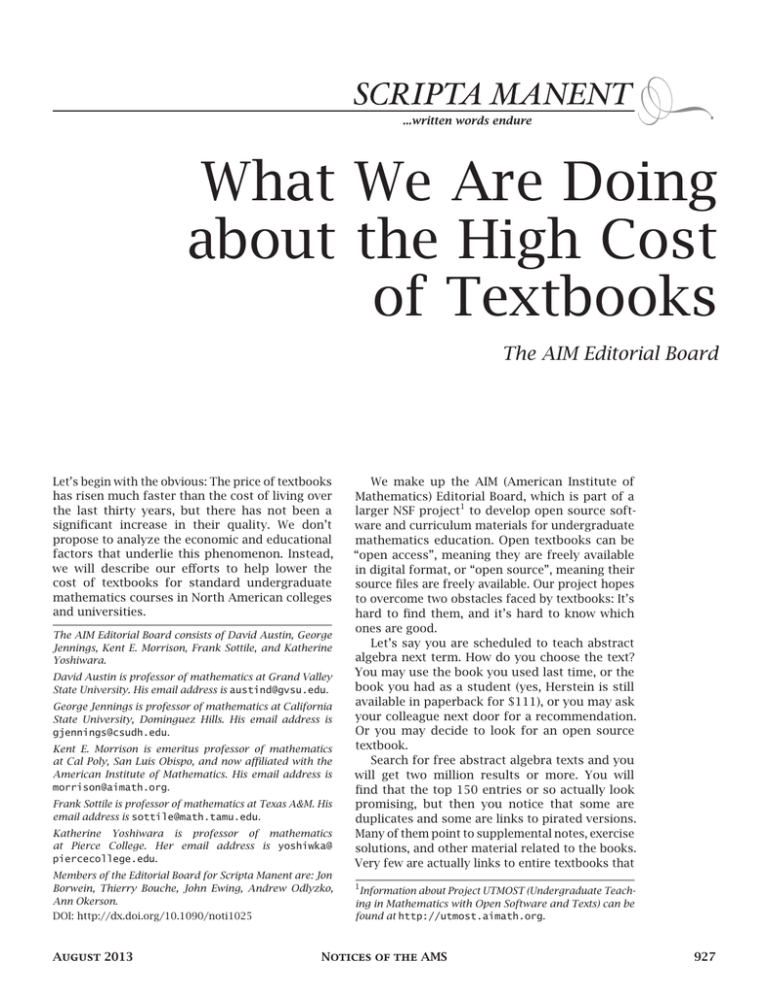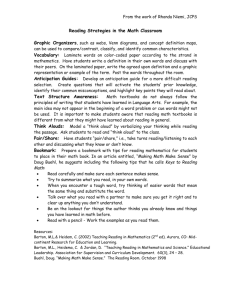What We Are Doing about the High Cost of Textbooks
advertisement

...written words endure What We Are Doing about the High Cost of Textbooks The AIM Editorial Board Let’s begin with the obvious: The price of textbooks has risen much faster than the cost of living over the last thirty years, but there has not been a significant increase in their quality. We don’t propose to analyze the economic and educational factors that underlie this phenomenon. Instead, we will describe our efforts to help lower the cost of textbooks for standard undergraduate mathematics courses in North American colleges and universities. The AIM Editorial Board consists of David Austin, George Jennings, Kent E. Morrison, Frank Sottile, and Katherine Yoshiwara. David Austin is professor of mathematics at Grand Valley State University. His email address is austind@gvsu.edu. George Jennings is professor of mathematics at California State University, Dominguez Hills. His email address is gjennings@csudh.edu. Kent E. Morrison is emeritus professor of mathematics at Cal Poly, San Luis Obispo, and now affiliated with the American Institute of Mathematics. His email address is morrison@aimath.org. Frank Sottile is professor of mathematics at Texas A&M. His email address is sottile@math.tamu.edu. Katherine Yoshiwara is professor of mathematics at Pierce College. Her email address is yoshiwka@ piercecollege.edu. Members of the Editorial Board for Scripta Manent are: Jon Borwein, Thierry Bouche, John Ewing, Andrew Odlyzko, Ann Okerson. DOI: http://dx.doi.org/10.1090/noti1025 August 2013 We make up the AIM (American Institute of Mathematics) Editorial Board, which is part of a larger NSF project1 to develop open source software and curriculum materials for undergraduate mathematics education. Open textbooks can be “open access”, meaning they are freely available in digital format, or “open source”, meaning their source files are freely available. Our project hopes to overcome two obstacles faced by textbooks: It’s hard to find them, and it’s hard to know which ones are good. Let’s say you are scheduled to teach abstract algebra next term. How do you choose the text? You may use the book you used last time, or the book you had as a student (yes, Herstein is still available in paperback for $111), or you may ask your colleague next door for a recommendation. Or you may decide to look for an open source textbook. Search for free abstract algebra texts and you will get two million results or more. You will find that the top 150 entries or so actually look promising, but then you notice that some are duplicates and some are links to pirated versions. Many of them point to supplemental notes, exercise solutions, and other material related to the books. Very few are actually links to entire textbooks that 1 Information about Project UTMOST (Undergraduate Teaching in Mathematics with Open Software and Texts) can be found at http://utmost.aimath.org. Notices of the AMS 927 can be obtained without cost. Then it takes time to follow the links and read enough to decide whether or not a book is a viable candidate for your course. With our project we are working to find, evaluate, and promote open textbooks in mathematics. We have created a short “approved list” of open textbooks organized by course name, with a link to each book’s website. We encourage authors to maintain an active website with more detailed information about their books, as well as errata sheets, links to reviews, course adoption lists, and contact information for comments and corrections. Such a website can help create an ecosystem around a book so that others can contribute to its improvement. An open textbook can be a shared community resource that remains current and won’t go out of print. The criteria we use to approve books are described in detail on our website.2 In brief, we are looking for books that can serve well as the required text in a course. We contact faculty who have actually used the books to find out what they think. Do they recommend the book in question? Would they use it again? Although we do not require that the books be available in printed format, we recommend that authors arrange for printing and distribution by companies such as Lightning Source, Lulu, Amazon, or Barnes & Noble. There are currently twenty-one books in thirteen courses on the approved list. Some of them began as commercially published textbooks whose copyrights were returned to the author. Others began as lecture notes and evolved into polished texts while remaining open access. Tom Judson’s Abstract Algebra: Theory and Applications, first published by PWS in 1994, is an example of how a textbook can become open source. After getting the copyright back, Judson released the text as open source with a GNU Free Documentation License. The mathematics department of Virginia Commonwealth University took the LATEX source, invested some time in formatting and editing, and arranged for Lightning Source to print and bind the book and for Amazon to sell it. The price is only $20 (hard cover) and the entire PDF version is available for no cost at the book’s website. You and your students can print your own copies or just the pages you want. You can arrange for a photocopy store or your campus bookstore to print copies for all of you, at a cost as low as $10. Of course, you don’t have to print it at all; you can read it on your computer or notebook. There is also a digital version in which each chapter is a Sage notebook that allows immediate computation with Sage, and there are Sage notebooks that contain just the exercises. (Sage is free open source software.) Some of the books are released with the GNU Free Documentation License mentioned above, while many have a Creative Commons license that is more restrictive in that it does not allow others to sell the book for profit but does allow them to charge the nominal cost of printing. Finally, a few of the books are commercially published, so that the publishers retain all the rights to print and distribute hard copies, but with open access PDF versions that can be printed for individual use. What motivates authors to forego the opportunity to earn money from their hard work? For many it is the experience gained from writing a commercially published book that did not yield rich returns, so the profit motive is weak for the next book. Authors would like their work to be used and appreciated, so they would like to make it widely available. For many a primary motivation is the desire to do something beneficial for the world. If you’d like to contribute to the open source movement, here are some things you can do. Give serious consideration to open textbooks, and let your colleagues know about them, too. Let the authors know when you use their texts and become part of the community by giving feedback, tracking errors and typos, and contributing supplementary material. Contribute a book review to the Open Academic Catalog at the University of Minnesota (http://open.umn.edu), where reviews and ratings of open texts in all subjects—not just mathematics—are being collected. Now that we have evaluated a number of books, we see the need for practical advice and guidance for authors who want to produce open source materials. We are creating a collection of recommended practices for all aspects of writing and publishing open mathematics textbooks, both in the current environment, where most books are read in a static version as PDF files or as printed copy, and in the new environment of constant Internet connectivity, mobile devices, and cloud computing. In a future column we would like to discuss the challenges and opportunities that an author faces under these rapidly changing conditions. 2 http://www.aimath.org/textbooks/ 928 Notices of the AMS Volume 60, Number 7



